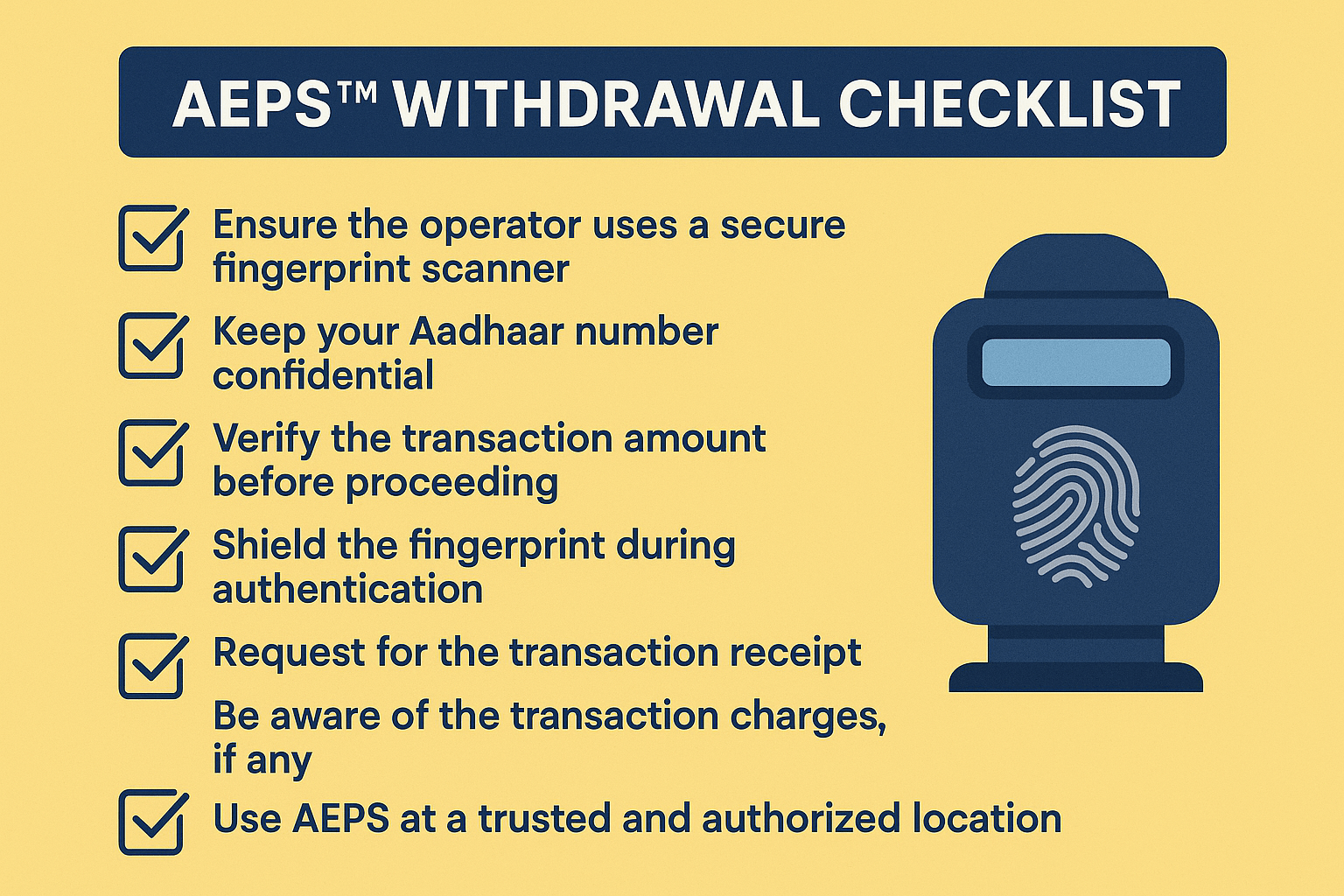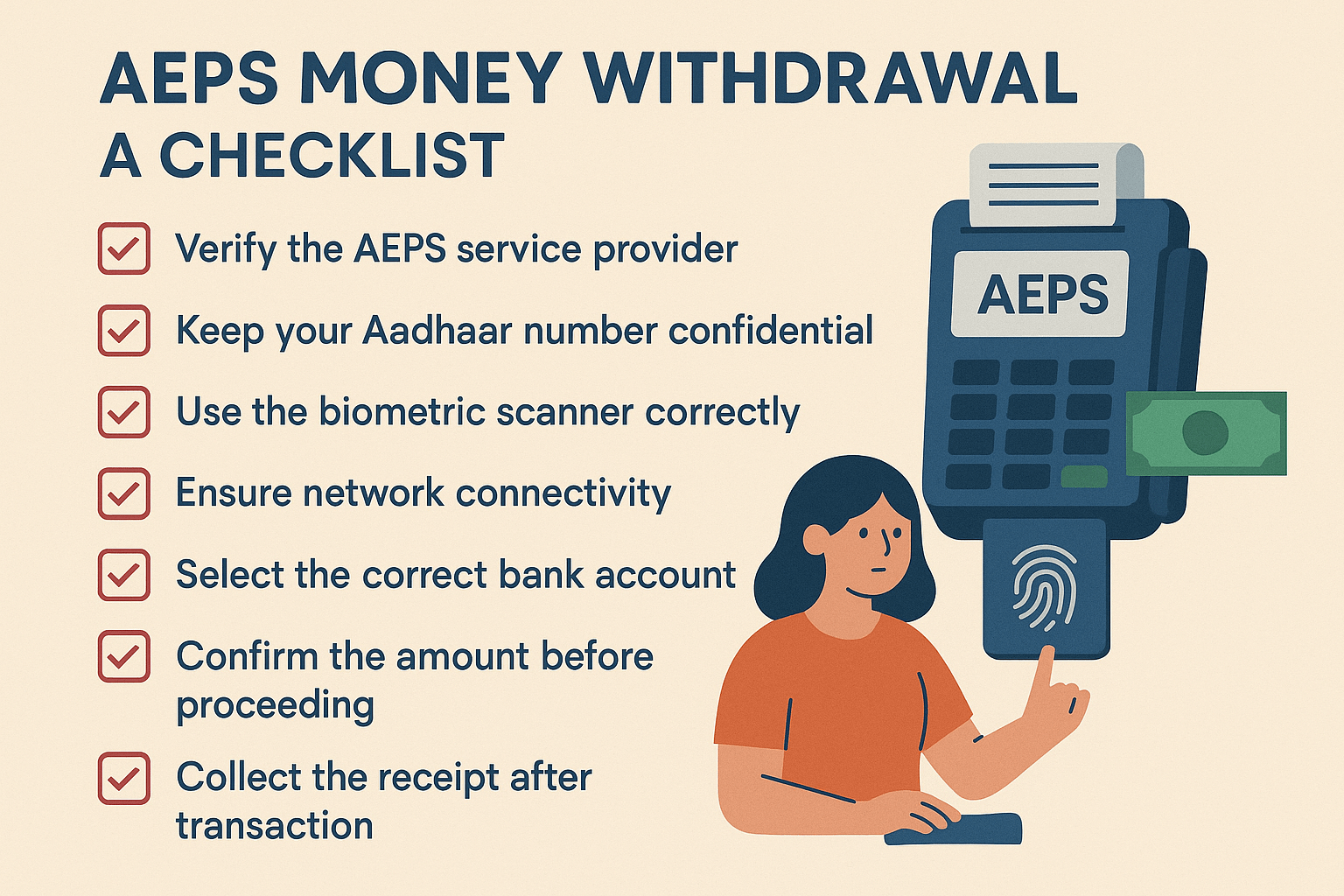Withdrawing money through the Aadhaar Enabled Payment System (AEPS) is a convenient way to access cash, especially in rural areas (AEPS Money Withdrawal) or places with limited banking infrastructure. However, to ensure a smooth and secure transaction, there are several things you must keep in mind. This guide provides a detailed checklist to help you withdraw money safely and efficiently using AEPS.
What is AEPS?
AEPS (Aadhaar Enabled Payment System) is a bank-led model that allows customers to perform basic banking transactions using their Aadhaar number and biometric authentication. It eliminates the need for debit cards, PINs, or signatures, making it an accessible option for millions of Indians.

Key Things to Keep in Mind While Withdrawing Money from AEPS
1. Ensure Your Aadhaar is Linked to Your Bank Account
Before using AEPS for money withdrawal, confirm that your Aadhaar number is linked to your bank account. You can check this by:
-
Visiting your bank branch
-
Using internet banking or mobile banking
-
Sending an SMS to your bank’s designated number
Example: If you have an SBI account, send an SMS “UID<space>Aadhaar number>” to 567676.
2. Choose an Authorized AEPS Service Provider
Only use authorized banking correspondents (BCs) or micro-ATMs for AEPS transactions. Avoid untrusted agents to prevent fraud.
3. Keep Your Aadhaar Number Handy
You’ll need your 12-digit Aadhaar number to initiate the transaction. Double-check it to avoid errors.
4. Verify the Transaction Charges
Some banks and BCs charge a small fee for AEPS withdrawals. Check the charges beforehand to avoid surprises.
5. Ensure Your Biometric Data is Updated
Since AEPS relies on fingerprint or iris scanning, make sure your biometrics are correctly registered with UIDAI. If your fingerprints are worn out (common among laborers), consider updating them at an Aadhaar center.
6. Check Your Bank Account Balance
Before withdrawing, ensure you have sufficient funds. Failed transactions due to low balance may still incur charges.
7. Confirm the Transaction Details Before Proceeding
-
Verify the amount to be withdrawn
-
Check the bank name (sometimes, multiple accounts are linked)
-
Ensure the merchant’s details are legitimate
8. Always Take a Receipt
A transaction receipt is proof of your withdrawal. It includes:
-
Transaction ID
-
Amount withdrawn
-
Remaining balance (if applicable)
9. Be Wary of Fraudulent Agents
-
Never share your Aadhaar number or OTP unnecessarily.
-
Avoid agents who ask for extra charges beyond the bank’s prescribed fees.
10. Monitor Your Bank Account Regularly
After withdrawing money via AEPS, check your bank statement or balance via SMS/mobile banking to confirm the correct deduction.

What to Do If an AEPS Transaction Fails?
-
Wait for a few minutes—sometimes, delays happen.
-
Check if the amount was debited using SMS or mobile banking.
-
If money is deducted but not dispensed, contact the BC agent immediately and raise a complaint with your bank.
Frequently Asked Questions (FAQs)
1. Can I withdraw money from AEPS without a bank account?
No, your Aadhaar must be linked to an active bank account for AEPS transactions.
2. Is there a daily withdrawal limit for AEPS?
Yes, most banks have a daily limit of ₹10,000 per transaction.
3. What if my fingerprint is not recognized?
You can use an iris scan (if enabled) or visit an Aadhaar center to update your biometrics.
4. Are AEPS transactions safe?
Yes, since it uses biometric authentication, it is secure. However, always transact through authorized agents.
5. Can I use AEPS at any micro-ATM?
Yes, as long as the micro-ATM supports AEPS and your bank is registered with the service.
Final Thoughts
Withdrawing money through AEPS is a simple and secure process if you follow the right steps. Always ensure your Aadhaar is linked, use trusted agents, and keep transaction records. By following this complete checklist, you can avoid common pitfalls and enjoy hassle-free cash withdrawals.
Disclaimer
This article is for educational purposes only. If you have any concerns regarding the content, please refer to our DMCA page for post removal guidelines. Always verify details with your bank before proceeding with financial transactions.
